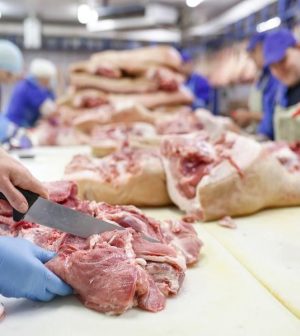- Navigating Your Midlife Crisis: Embracing New Possibilities
- City Raccoons Showing Signs of Domestication
- Mapping the Exposome: Science Broadens Focus to Environmental Disease Triggers
- One Week Less on Social Media Linked to Better Mental Health
- Your Brain Changes in Stages as You Age, Study Finds
- Some Suicide Victims Show No Typical Warning Signs, Study Finds
- ByHeart Formula Faces Lawsuits After Babies Sickened With Botulism
- Switch to Vegan Diet Could Cut Your Greenhouse Gas Emissions in Half
- Regular Bedtime Does Wonders for Blood Pressure
- Dining Alone Could Mean Worse Nutrition for Seniors
Meatpacking Plants Accounted for 334,000 U.S. COVID Cases: Study

Meatpacking plants were the source of an estimated 334,000 COVID-19 cases in the United States, according to a new study. It puts the economic toll stemming from those cases at $11.2 billion.
And study author Tina Saitone, a livestock and rangeland economics cooperative extension specialist at the University of California, Davis, said those numbers are conservative.
The research included U.S. counties with large meatpacking plants that produced more than 10 million pounds a month. The investigators looked at infections within 150 days after the first documented COVID case in each county.
Beef- and pork-processing plants more than doubled infection rates in counties where they were located, while chicken-processing plants increased rates by 20%, according to the study.
Explaining why they believe the true numbers are likely higher, the researchers noted they focused on infection rates within counties with meatpacking plants and didn’t account for cases that might have been contracted at a meatpacking plant but spread to other counties.
“Similarly, our study likely understates true economic losses,” Saitone said in a university news release.
While the study assessed lost wages and deaths, it did not include long-term health care costs, or the costs of worker safety measures.
“While we did see an initial ramp up in cases attributable to meatpacking facilities, over time infection rates were the same per capita as counties without them, partly because meatpacking plants implemented a lot of protocols to protect employees,” Saitone said.
The COVID pandemic led to massive disruptions in the food supply chain. Some critics have said a smaller, more geographically dispersed industry would make it less susceptible to a pandemic, the researchers noted.
But such a change would add to costs and increase food prices, they pointed out.
Instead, economists suggest the meatpacking industry could look into automation and technological innovations that made the poultry industry more resilient to the COVID-19 pandemic.
The results were published online recently in the journal Food Policy.
More information
The U.S. Centers for Disease Control and Prevention has more on meat/poultry plants and COVID-19.
SOURCE: University of California, Davis, news release, April 15, 2021
Source: HealthDay
Copyright © 2025 HealthDay. All rights reserved.










